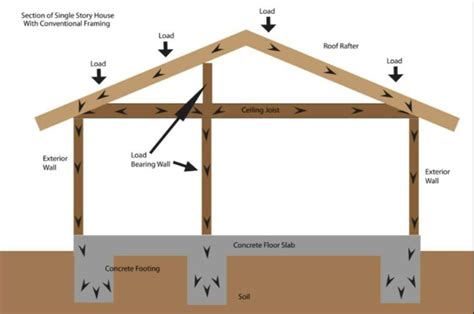Uncover the Secrets of Load-Bearing and Non-Load-Bearing Walls: A Comprehensive Guide for Building Success
Understanding the Basics of Load-Bearing and Non-Load-Bearing Walls
In the realm of construction, understanding the difference between load-bearing and non-load-bearing walls is crucial for ensuring structural integrity and architectural soundness. Load-bearing walls are the backbone of a building, supporting the weight of all the elements above them, including floors, roofs, and ceilings. They must be designed and constructed with exceptional strength and durability. In contrast, non-load-bearing walls do not bear any weight and serve primarily to divide or define spaces within a structure. They are typically thinner and lighter than load-bearing walls.
| Load-Bearing Walls |
Non-Load-Bearing Walls |
| Supports weight of upper structures |
Divides spaces within a building |
| Structural integrity is critical |
Architectural flexibility |
| Requires thicker and stronger materials |
Can be thinner and lighter |
| Modification requires professional engineering |
Can be modified more easily |
Getting Started with Load-Bearing and Non-Load-Bearing Walls
Navigating the complexities of load-bearing and non-load-bearing walls can be daunting. Follow these steps to ensure a successful project:
-
Identify Load-Bearing Walls:
- Inspect walls for vertical supports such as beams or columns.
- Check for thicker materials and robust construction techniques.
- Consult blueprints or consult with a structural engineer.
-
Plan for Non-Load-Bearing Walls:
- Determine space division and architectural design requirements.
- Select lightweight materials such as drywall, plaster, or glass.
- Ensure stability by anchoring walls to load-bearing elements.

| Tips for Identifying Load-Bearing Walls |
Tips for Planning Non-Load-Bearing Walls |
| Check for presence of vertical supports |
Use lightweight materials for flexibility |
| Assess wall thickness and construction methods |
Anchor walls securely to load-bearing elements |
| Consult professional engineers for guidance |
Consider architectural design implications |
Pros and Cons of Load-Bearing and Non-Load-Bearing Walls
Load-Bearing Walls:
Pros:
- Structural integrity and stability.
- Long-lasting and durable.
- Provides a solid foundation for upper structures.
Cons:
- Limited architectural flexibility.
- Modifications require professional engineering.
- Can be more expensive to construct.

Non-Load-Bearing Walls:
Pros:
- Architectural flexibility and design freedom.
- Easy to modify or remove without structural compromise.
- Lightweight and cost-effective.
Cons:
- Not suitable for supporting weight.
- Requires anchoring to load-bearing elements.
- May not provide adequate sound insulation.
Stories of Success: The Benefits of Load-Bearing and Non-Load-Bearing Walls
1. Strength and Stability:
Benefit: A load-bearing wall in a commercial building supported a heavy mezzanine, allowing for maximum space utilization without compromising structural integrity.
How to: The wall was constructed using reinforced concrete, engineered to withstand the weight of the mezzanine and its contents.
2. Architectural Flexibility:
Benefit: Non-load-bearing walls in a residential home allowed for a spacious open plan living area while maintaining the structural integrity of the building.
How to: The non-load-bearing walls were constructed using drywall, anchored securely to the surrounding load-bearing walls.

3. Cost-Effectiveness:
Benefit: In a multi-story office building, non-load-bearing walls were used to create smaller, more efficient office spaces at a significantly lower cost than constructing additional load-bearing walls.
How to: The non-load-bearing walls were constructed using lightweight gypsum board, reducing construction materials and labor costs.
Effective Strategies for Managing Load-Bearing and Non-Load-Bearing Walls
-
Plan Early: Determine the location and function of load-bearing and non-load-bearing walls during the design phase.
-
Consult Professionals: Seek advice from structural engineers for complex load-bearing wall modifications.
-
Use Appropriate Materials: Select materials with the strength and durability required for load-bearing applications.
-
Ensure Proper Anchoring: Secure non-load-bearing walls securely to load-bearing elements to prevent structural instability.
-
Consider Architectural Implications: Design non-load-bearing walls to complement the overall architectural style and functionality of the building.
-
Involve Contractors: Engage experienced contractors for professional installation and modifications of load-bearing walls.
Tips and Tricks for Optimizing Load-Bearing and Non-Load-Bearing Walls
-
Use Structural Reinforcement: Reinforce load-bearing walls with steel beams or concrete pillars for increased strength.
-
Consider Wall Thickness: Thicker load-bearing walls provide better load-bearing capacity.
-
Plan for Openings: Design openings in load-bearing walls with appropriate lintel or arch supports.
-
Maximize Natural Light: Install windows in non-load-bearing walls to bring in natural light and reduce energy consumption.
-
Utilize Demountable Partitions: Use demountable partitions for non-load-bearing walls to create flexible and adaptable spaces.
Common Mistakes to Avoid When Working with Load-Bearing and Non-Load-Bearing Walls
-
Altering Load-Bearing Walls Without Professional Approval: Modifying load-bearing walls without proper engineering can compromise structural integrity.
-
Overloading Non-Load-Bearing Walls: Placing heavy objects on or attaching excessive weight to non-load-bearing walls can cause bowing or collapse.
-
Insufficient Anchoring: Failing to securely anchor non-load-bearing walls to load-bearing elements can lead to structural instability.
-
Ignoring Building Codes: Not adhering to building codes and regulations can result in legal issues and safety hazards.
-
Overlooking Architectural Impact: Designing non-load-bearing walls without considering their architectural context can detract from the overall aesthetic appeal of the building.

